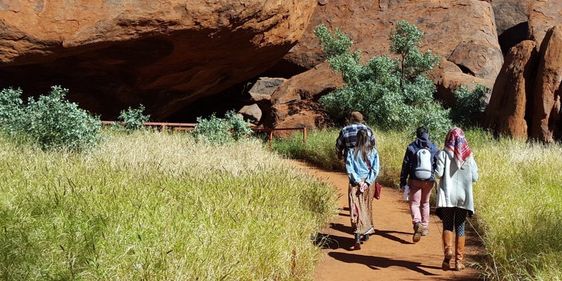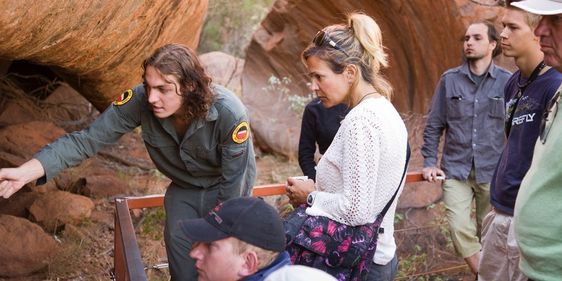Rock art
The rock art around Uluṟu is evidence of how cultural knowledge and Tjukurpa stories have been passed from generation to generation.
The park’s rock art sites have many layers of pictures, symbols and figures painted on top of each other. This is because the same sites have been used in Aṉangu education for tens of thousands of years.
The rock surfaces are like a classroom blackboard that a teacher has used to illustrate a lesson, and only those who attend the class can fully decipher the notes left behind.
Aṉangu rarely create new rock art now. However, old rock art and sand drawings (along with paintings on canvas) are used to teach creation stories and ensure the continuation of knowledge.
How old is the rock art at Uluṟu?
It is extremely difficult to accurately date the rock art at Uluṟu. Carbon dating can only pick up the age of the rock and the materials used for the pigments, rather than the paintings themselves.
However, people are believed to have lived in the Uluṟu region for at least 30,000 years. The rock art is an important historical and scientific record of human occupation in this area.
How were the paints made?
Aṉangu traditionally made their paints from natural minerals and ash. The dry materials were placed on flat stones, crushed and mixed with kapi (water) or animal fat.
The most common paint colours are red, yellow, orange, white, grey and black. These colours come from a variety of materials. Tutu (red ochre) and untanu (yellow ochre) are iron-stained clays that were very valuable and traded across the land. Burnt kurkaṟa (desert oak) provides both purku (black charcoal) and tjunpa/unu (white ash).
Rock art conservation
Aṉangu Traditional Owners work with park staff to document and conserve around 80 rock art sites.
The rock paintings are easily damaged because they are made from natural pigments. Water, dust, minerals from the rock, lichen, wasp nests and other animals are just some of the threats that can cause fading, flaking and other damage.
Art sites are also damaged when people touch the artwork or graffiti the sites. In the early days of Uluṟu tourism, many tour guides even poured buckets of water on the art to bring out the colours and make them look better in black-and-white photos. This practice damaged the art and thankfully was stamped out long ago.
Viewing platforms have been built at the most popular art sites to reduce dust and damage. You can help us look after Uluṟu’s precious rock art by admiring and photographing the works, but never touching them.
Where can I see rock art?
You can see art in several rock shelters along the Mala walk and Kuniya walk.
The free ranger-guided Mala walk includes a whole section dedicated to rock art.



